Recently, thanks to reader Mike up in Canada, I’ve had the opportunity to look into Hungarian embroidery. I love regional embroidery techniques, especially the types that reflect the social heritage of a nation. I don’t know a lot about Hungarian embroidery – I’m just beginning to learn a little bit about it. Before my interest in it was recently awakened, what I knew about traditional embroidery from Hungary was pretty vague: that it is colorful, that it sometimes involves cross stitch and sometimes involves cutwork or lace, and that it is often employed (quite exuberantly!) in the national costumes of Hungary.
Any time I begin a new journey into learning about a type of needlework, I start with searching online for resources and searching for books. One of the most helpful websites I came across in my preliminary search into Hungarian folk art and Hungarian embroidery was Folkology. It was here that I found titles of various books in Hungarian on Hungarian embroidery, with brief reviews of the books’ contents. Though the books are no longer available on Folkology, I was able to do some searching and land a few through used books sources. The first one that arrived is called Nagyanyáink öröksege, or “Legacy of our Grandmothers.”
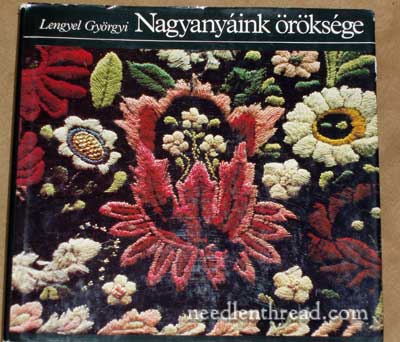
The cover of the book says a lot the type of needlework within – that it is colorful, indeed. It also has a bit of a rustic flavor to it, as does most folk embroidery.
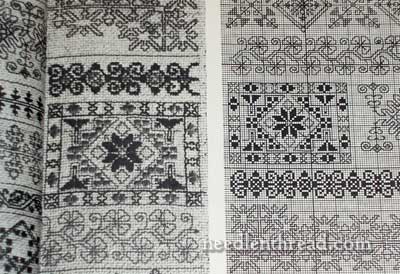
I was happy to know that I was right about cross stitch. The book begins with cross stitch – showing the worked piece, lined up next to a clear chart for reproducing the design. Although there is one section of colored plates in the book, the majority of photos are black and white, but they are clear, and although the text of the book is in Hungarian (as it should be!) the pictures say a lot! The book was printed in 1986.
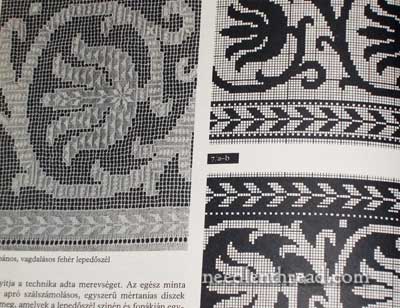
Aha – something begins to unfold: Hungarian embroidery is diverse in technique! Whitework, with filet netting, is featured in the book. And it is delicate and beautiful.
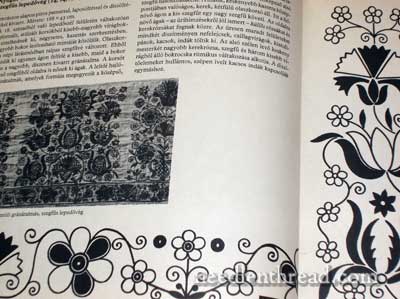
Ooooh. For color! But still, you can imagine the bold colors in the embroidered piece featured here. Along with the photos of embroidered works, almost every page or so presents patterns of one kind or another. The patterns for the surface work are bold, folk-like designs, with lots and lots of flowers.
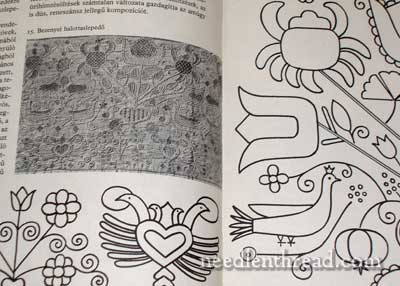
Some kind of whitework is pretty much always found in regional embroidery styles from the European continent, and Hungary is no exception. There are several pieces of whitework displayed throughout the book. This particular design, with its tulips and hearts and flowers, reminds me very much of Schwalm embroidery from Germany, though it is a little more crowded!
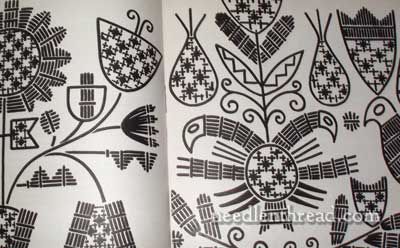
You can see the rustic designs here, featuring very stylized birds. Not all the designs in the book indicate what types of stitches would be used, but this spread of motifs suggests various fillings.
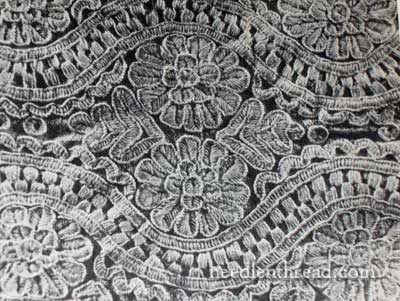
Many of the pieces displayed in the book are thick with embroidery. The use of buttonhole stitch seems to be favored in this piece – along with some satin stitched alternating blocks in the wavy lines.
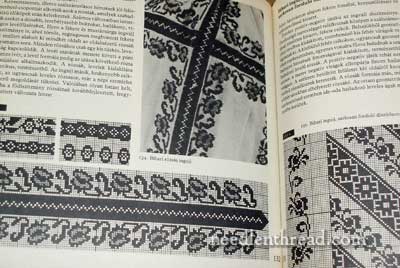
Throughout the book, various cross stitch designs are included, with photos of their use on what looks to be clothing or parts of clothing. On this page, the worked piece in the top right corner looks to be a sleeve. Very beautiful! I would guess – but I could be Really Wrong, and I’m certainly up for correction! – that red would be a dominant color in these motifs.
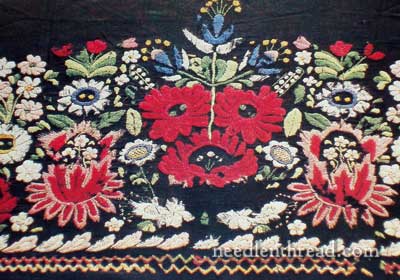
The color plates show off the bright colors of the embroidery, which is even more enhanced when worked on dark backgrounds.
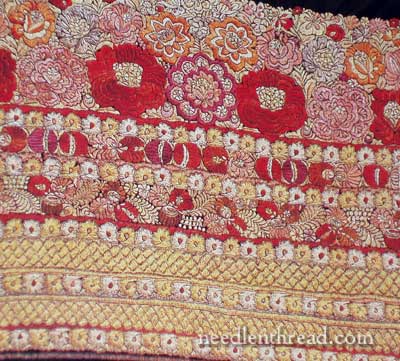
This piece is stunning. The embroidery is lush. The color combination is beautiful. And the lower stripes of criss-crossed satin stitches (the diamond pattern in gold) is so beautiful!
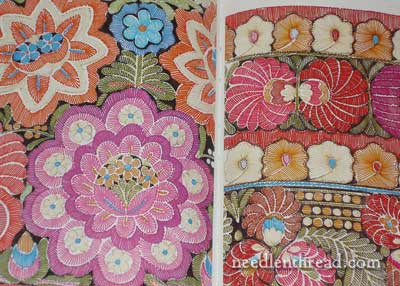
Here you see some colored patterns for embroidery. These patterns clearly indicate stitches and stitch direction.
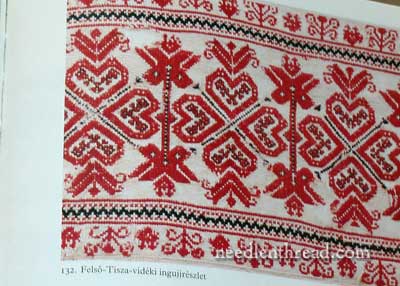
A vibrant red-on-white band, with a touch of black is featured on one page, along with a pattern for the same. Striking, isn’t it?
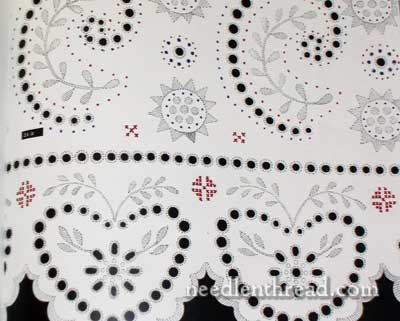
Returning to the notion of whitework, there are some beautiful examples of whitework touched with red, with intricate eyelets and pretty scalloped edges.
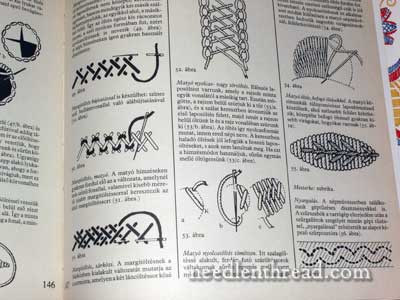
The book has clear diagrams for the stitches commonly used. It is easy to interpret the stitches, even without a translation.
No doubt about it – I am going to enjoy looking into Hungarian embroidery a little more deeply. In the meantime, I’ve learned that there are two distinct styles of Hungarian embroidery that are well known – Kalocsa, which features flowers and eyelet work, and Matyó, which is what I would call thick, lush embroidery – packed with color and flowers, especially roses. One book I’m especially interested in finding is titled The Matyó Roses, but I’ve not had any luck tracking it down. It looks like an interesting book on the culture of the region, with good information about the embroidery of the area, too.
If you know of any good books or resources on the subject of Hungarian embroidery, please leave a comment below and share what you know! If you’re interested, I’ll keep you abreast of what I find out, too.
Hope you enjoy your Monday!




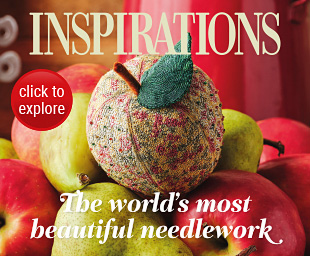


Hello from Hungary. 🙂
I have visited the Matyó Museum in Mezőkövesd as a child, and have seen the beautiful embroideries too…
Here is their webpage:
http://www.mezokovesd.tajhaz.hu/
Similar style is the Kalocsa embroidery, named from one of the cities from the region.
http://www.kalocsa-embroidery.com/
I’m a cross stitcher mainly, but I love all the other forms of my country’s embroidery.
One of the old cross stitch books of Hungary – Gyergyókilyénfalvi Keresztszemesek – is public domain now, and can be found on several webpages, for example here.
http://qtp.hu/xszemes/gyergyoi_keresztszemes_mintak.php
I have got an original book too. 🙂
If you have something in mind concerning Hungarian emborideries, please ask, and I try to answer.
I have been searching all over Google to decode the unique embroidery styles from regions around Hungary. Specifically, my grandma originated from Szekesfehervar, of the fejer county. The regions I have found that seem to cover that area is Central Transdanubia?. I cannot find an embroidery style attached to that region. Also I don’t know any hungarian.. it’s been frustrating! My grandma past several years ago now and there is no one that has any clue how to help me solve this. I really hope you can open my eyes to this to a bit of your amazing culture!!
Dear Mary ,
What a treat. My father was from Hungary. His mother My grandmother was a Hungarian needlewoman. My earliest memories are of beautiful colorful embroideries livening the tiny living room. I have that love of embroidery and folk art in my fingers. I am now actually looking at some of my old textile designs, so influenced by these patterns and the rich history behind it. I plan to embroider a loose cotton jacket for next summer
so, I have to find a soft cotton or linen. I think I will do it on white. Again Thank you
and by the way one of the links you gave us
is actually a whole book’ worth of motifs.
I feel so gifted.
Marcia
Happy in New York.
On Googling The Matyó Roses it come up with this website where you can buy the book:
http://shop.folkology.com/products/the-matyo-roses-viewbook-about-matyo-folk-art-culture
I look forward to reading your newsletter each day. Thank you and Merry Christmas to you and yours.
Thanks so much Dear Marymentor..
This one really whets my appetite. It’s so cold here it Pittsburgh, so suddenly; and my fingers need to stay busy. I love the “primitive” look of some of these and I can see a lot of it done in wool. Thanks again. You always come across 🙂
Yes, this is where it all began for me — at the knee of my Hungarian grandmother. She was a remarkable woman and we WERE kindred spirits! My early-on attraction to embroidery was totally “ethnic” and remained so. When FolkWear Patterns came out in the 70’s, I was thrilled. Thanks for touching that nerve AND thanks to your reader, KerGiz, for her information!
eBay has a seller that specializes in books of eastern european embroidery.
http://stores.ebay.com/Eastern-European-Art
Many I’ve found there I’ve been able to purchase used from Amazon.
Hi Mary,
Hungarian embroidery is still a favorite of mine since taking 2 Kalocsa embroidery courses from EGA in 2001 & 2002. The instructor is Eniko Farkas who lives in Ithaca, NY. The first course’s goal was a colorful embroidered bouquet of stylized flowers in two color combinations, happy & sad. The second course’s goal was to surround one of those pieces with needlelace.
I have collected several books and examined others through interlibrary loans. Some examples are: “Kalocsai viragok” by Lengyel Gyorgyi and “Kalocsai Gephimzes” by Kardos Katalin. Another excellect reference for Hungarian embroidery in general is in the EGA Magazine, Needle Arts, September and December, 1997. The articles are “A Needlework Tour of Hungary”, Pt. 1&2, excellent information and pictures.
Marti
I found your book at http://www.shopfolkology.com for $39.00 US. However, it is on back order.
Colleen Lim
Mary,
This is so interesting! Thank you to you and your readers for such great resources. You make embroidery so accessible! I really look forward to your posts. Have a great day!
Hola! te agradezco tanto todo lo que me mandas , hasta ahora los he bordado casi todos . La informacion que me das a traves de tu blog es estupenda y los videos geniales .
Gracias muchas gracias por todo
Hello Mary,
Thanks so much for sharing what you’ve learned. My parents were both from Hungary, and while I had no relatives or friends to teach me the art, we always had some Hungarian embroideries in our home when I was growing up. One type was a very rustic form of redwork that was done almost entirely in blanketstitch with quite thick red cotton (think perle cotton), on heavy handwoven natural coloured linen fabric. The motifs were often vases of flowers, sometimes birds. This type of embroidery was used for everyday household items like pillowcases, tablecloths, doona covers etc, and was probably widespread in Hungary but the items in our home came from western Hungary. I also have a very fine needle-lace doily and bridegroom hanky that were given to me as wedding presents by my great aunt. The hanky has eyelets and satin stitch motifs similar to ayrshire embroidery, and the doily needlelace stitches are similar to those used in schwalm embroidery, but the stitches and fabric are much finer. Another common form of handwork that appears together with embroidery is smocking. I have a beautiful Hungarian blouse that has Kalocsa style embroidery at the neckline and on the sleeves, with beautiful smocking at the wrists and waistline. Thanks so much Mary, you have inspired me to delve outside the comfort of bullionstitch roses to find out more about the embroidery of my forebears.
Hi Mary,
a great post like always. Your blog is full of inspiration. Thank you 🙂
I know some books about hungarian embroidery, they are public domain and you can download it from the National Hungarian Library
http://mek.oszk.hu/html/vgi/kereses/keresesujgy.phtml?tip=gyors
Mostly not in color and in hungarian, but I think you will like it. If the link doesn`t work, here are the direct links to the PDFs
http://mek.oszk.hu/01800/01857/01857.pdf
http://mek.niif.hu/07500/07563/07563.pdf
http://mek.oszk.hu/07800/07867/07867.pdf
http://mek.oszk.hu/07600/07619/07619.pdf
http://mek.niif.hu/07900/07930/07930.pdf
Have a nice day 🙂
Thanks so much, wassernixe, for the links! The books are wonderful – I just browsed through each of them! I wasn’t able to get anything on the overall link, but the individual PDFs came up fine. Thanks again! ~MC
Hi
I spent couple of hours this morning reading your blog and watching the stitch tutorial videos. Really nice, inspiring work.
If you need any help to translate some stuff from the Hungarian book, let me know, I’m from Hungary and I would gladly help. LOVE embroidery’and love your works.
GiGiNall
Thanks, Gigi!
I live in Hungary and though I’m not an embroiderer, i love it and have always wanted to give it a try. I never tire of admiring the embroidery I see everywhere – especially when I come across a unique piece at the antique piac (open air market). I found a book quite some time ago, called Hungarian Folk Designs for Embroiderers and Craftsmen by Anna Szalavary. It gives outlines of embroidery pattern elements and is sorted by region in Hungary with a brief description of colors typically used in each area. I have used them as patterns at paint-it-yourself pottery shops, but hope to try embroidery some day. (I enjoy sewing and crochet, and have done a lot of cross stitch.) Anyway, in enjoyed happening across your site, and was happy to see the sections on Hungarian embroidery. It is an intricate and beautiful art!
Here is an Hungarian site that has images of the book for those who would like to see more so that they can decide whether or not they would like to purchase it:
http://xfree.hu/album_show.tvn?aid=104556
The book is available for purchase on Amazon.
JT
I was excited to read this as we have good friends in HU and am anticipating a wedding next year. I plan to do a Hungarian counted cross stitch and have been in contact with a woman(Katalin Torok) who’s website (Folkology.com) appears to be down. Hopefully, sher will respond to you as well. Good luck
I like your website so much it is so interesting i dashed through it because of a project but I think later I want to read through it carefully. The hungarian culture seems so facinating!
I would like to know more about the Czengeri (Szabolcs)Hungarian style of embroidery. This is found around the city of Kisvada (Eastern Hungary, near the Tizsa River)I think I found an example at the following link….https://www.pinterest.com/pin/63754150953198389/ I would like to more details about this style of embroidery.
I wanted to tell Renee about this website.
You could search the archives for your region. The author of this blog covers many regions in costume and embroidery.
http://folkcostume.blogspot.com
Will u be offering the entire book for sale? From what region of Hungary are the patterns? I am very interested in learning more about the book. Please respond ASAP.
Helen Duer
My father from Hungary
This is an out-of-print book. You’ll have to search for it through used book sources. Hope that helps!
Hungarian Folk Designs by Anne Szalavary